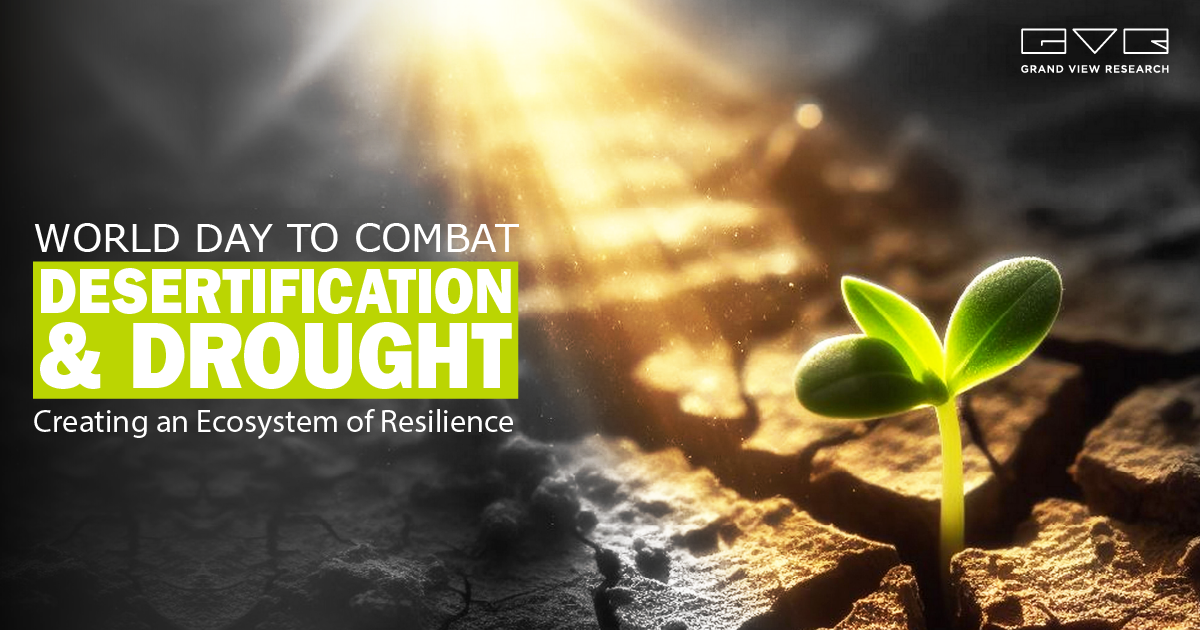World Day to Combat Desertification and Drought - Creating An Ecosystem of Resilience
The World Day to Combat Desertification and Drought is celebrated each year on June 17th to raise public awareness of land degradation, desertification and drought. Under the United Nations Convention to Combat Desertification (UNCCD), more than 130 countries have pledged to achieve land degradation neutrality by 2030. Meanwhile, the UN warns that droughts could impact around three-quarters of the global population by 2050, while an equivalent of four football fields of healthy land becomes degraded every second. Drought resilience has become indispensable for sustainable water management, landscape restoration, proactive measures, disaster preparedness and regenerative agriculture.

The world stands at a crossroads-droughts are monumental threats to sustainable development across developing and developed economies.
Africa suffered economic losses of over USD 70 billion in the past 50 years, while the region contributed 44% to all severe droughts (globally recorded) in the past century.
Where Does Africa Stand?
At a time when desertification has spiraled out of control and wreaked havoc, Africa stands at a critical juncture to withstand or surmount droughts, floods and storms. In Q1 2024, a prolonged dry spell in Southern Africa dented food security and crops, largely due to El Niño (a weather pattern that normally brings below-average rainfall to Southern Africa, Western East Africa, and LAC, while an above-average rainfall to East Africa). It is worth mentioning that over 300 events of severe droughts were recorded in 100 years, affecting more than any other continent.
The silver lining amidst the cacophony is investment in drought resilience. In essence, mobilizing investments in drought resilience and creating political momentum are major pillars of the IDRA (International Drought Resilience Alliance).
Africa is leaving no stone to bolster its ecosystem restoration and sustainable land management practices. It uses the Great Green Wall in the Sahel and early warning systems, including the Africa Flood and Drought Monitor in the Lake Chad basin. Africa reportedly witnessed 20 sustainable bond issuances, such as water-related infrastructures and a surge in green bonds to finance projects. Prominently, weather-indexed insurance programs have helped farmers recover from drought in Ethiopia, unlocking avenues to access credit and invest in fertilizers to boost agricultural productivity and save money.
Climate-Smart Agriculture Helps Win Today’s Race while Running Tomorrow’s
Lingering water scarcity has spotlighted climate-smart agriculture (CSA) to revitalize drought-prone ecosystems and underscore water resource management. CSA is in the vanguard position to promote sustainable development and address climate change issues. Citing the FAO’s 2023 edition of the State of Food Security and Nutrition in the World report, the UN noted that 2.4 billion people experienced moderate or severe food insecurity, while around 691 to 783 million people grappled with hunger in 2022.
CSA has become a trailblazer in fostering resilience, bolstering productivity and minimizing GHG emissions. Some dynamics that exhort the need for climate-smart agriculture to surmount drought are delineated below:
-
The agricultural practice helps produce high-quality food, enhance income and reinforce nutrition security.
-
CSA has become instrumental in underscoring carbon sequestration in plants and soils and negating deforestation on the back of cropland expansion.
-
CSA prioritizes the tradeoffs and synergies among adaptation, productivity and mitigation.
Policy makers, industries and other stakeholders are expected to inject funds into CSA to address challenges in the value chain and achieve sustainable, green and climate-resilient agriculture. The World Bank asserts that climate-smart agriculture and nature-based solutions are required to be scaled-up to protect forests and overcome food insecurity.
Turning Adversity into Opportunity Sustainability-linked Loans
Agricultural finance institutions are supporting farmers who have adopted climate-smart technologies and practices. For instance, green loans, green bonds and sustainability-linked loans have become invaluable tools for achieving sustainability targets. In essence, stakeholders are likely to seek sustainability-linked loans to improve energy efficiency and minimize GHG emissions. Farmers, their lenders, and agricultural businesses are poised to join forces with agricultural producers to assess climate-related challenges.
The Need for Proactive Actions-Road Map
The prevailing challenges speak volumes about the need to taper off desertification and drought. Stakeholders are expected to emphasize regenerative agricultural practices, sustainable water management and disaster preparedness. The world should navigate toward sustainable solutions rather than destructive actions.
To schedule a free market intelligence database demo, please complete the form below:
Service Guarantee
-
Insured Buying
This report has a service guarantee. We stand by our report quality.
-
Confidentiality
Your transaction & personal information is safe and secure.
-
Custom research service
Design an exclusive study to serve your research needs.
-
24/5 Research support
Get your queries resolved from an industry expert.